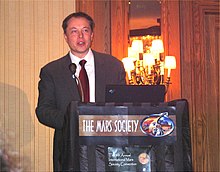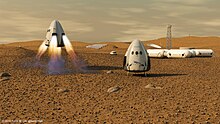SpaceX has stated its ambition to facilitate the colonization of Mars via the development and mass manufacturing of the Starship launch vehicle. The company states that this is necessary for the long-term survival of the human species and for the expansion of the scope of human consciousness.[1]

Elon Musk, who founded SpaceX, first presented his goal of enabling Mars colonization in 2001 as a member of the Mars Society's board of directors. In the 2000s and early 2010s, SpaceX made many concepts for Mars, including space tugs, heavy-lift launch vehicles, and Red Dragon capsules. The company's current plan was first formally proposed at the 2016 International Astronautical Congress alongside a fully-reusable launch vehicle, the Interplanetary Transport System. Since then, the launch vehicle was renamed to "Starship", and has been in development since. The development program reached multiple milestones in 2024 such as on its third test flight, it reached its desired trajectory for the first time and on its fourth flight test, both stages of the vehicle achieved controlled splashdown after launch for the first time. The company has given many estimates of dates of the first human landing on Mars; the most recent discussion of which occurred during a company all hands meeting in April 2024.[2]
SpaceX's early missions to Mars will involve small fleets of Starship spacecraft, funded by public–private partnerships.[3]The company hopes that once infrastructure is established on Mars and launch cost is reduced, colonization can begin. The program has been criticized by some people as far-fetched, because of uncertainties regarding its financing[4] and because it primarily addresses transportation to Mars and not the steps that follow. George Dvorsky writing for Gizmodo characterized Musk's timeline for Martian colonization as "stupendously unreasonable".[5] For reference, Musk's timeline for the colonization of Mars involves a crewed mission as early as 2029 and the development of a self-sustaining colony by 2050.[6]
Some experts, like Robert Zubrin, support the concept due to the prevalence of water ice in the form of permafrost and glaciers on Mars, as well as other resources like carbon dioxide and nitrogen;[7] some are opposed to the concept, believing the planet's lack of both breathable air and protective magnetosphere to be unacceptable problems.[8] A common sentiment among those opposed to expanding the scope of human civilization to Mars is that humans should focus on solving the problems on Earth before advancing to extraplanetary colonization.[9]
Prior mission concepts
Mars Colonial Transporter
Red Dragon capsule

Red Dragon
Red Dragon was a 2011-2017 concept mission which would have used a modified Dragon 2 spacecraft as a low-cost Mars lander. If flown, it would have been launched on a Falcon Heavy, and land solely via the use of its SuperDraco retro-propulsion thrusters,[18] as parachutes would have required significant vehicle modifications.[19]
In 2011, SpaceX planned on proposing Red Dragon for the Discovery Mission #13, which would launch in 2022,[20][21][22] but it was not submitted. It was then proposed in 2014 as a low-cost way for NASA to achieve a Mars sample return by 2021. In the concept, the Red Dragon capsule would be equipped with the system needed to return samples gathered on Mars. NASA did not fund this concept.
In 2016, SpaceX planned on launching two Red Dragon vehicles[23] in 2018,[24][25] with NASA providing technical support instead of funding.[26] However, in 2017, Red Dragon was cancelled, in favor of the much larger Starship spacecraft.[27]
Program manifest
SpaceX has stated on several occasions aspirational plans to build a crewed base on Mars for an extended surface presence, which it hopes will grow into a self-sufficient colony.[28][29] A successful colonization, meaning an established human presence on Mars growing over many decades, would ultimately involve many more economic actors than SpaceX.[30][31][32]
Before any people are transported to Mars, a number of cargo missions would be undertaken first in order to transport the requisite equipment, habitats and supplies.[33]Equipment that would accompany the early groups would include "machines to produce fertilizer, methane and oxygen from Mars' atmospheric nitrogen and carbon dioxide and the planet's subsurface water ice" as well as construction materials to build transparent domes for crop growth.[34][35]
Musk has made statements on several occasions about aspirational dates for Starship's earliest possible Mars landing,[36] including in 2022, that a mission to Mars could be no earlier than 2029.[37]
Exploration

Musk plans for the first crewed Mars missions to have approximately 12 people, with goals to "build out and troubleshoot the propellant plant and Mars Base Alpha power system" and establish a "rudimentary base." The company plans to process resources on Mars into fuel for return journeys,[38] and use similar technologies on Earth to create carbon-neutral propellant.[39]
Tenets
As early as 2007, Elon Musk stated a personal goal of eventually enabling human exploration and settlement of Mars,[40] although his personal public interest in Mars goes back at least to 2001 at the Mars Society.[41]: 30–31 SpaceX has stated its goal is to colonize Mars to ensure the long-term survival of the human species.[4]
Launch vehicle

Starship is designed to be a fully reusable and orbital rocket, aiming to drastically reduce launch costs and maintenance between flights.[42]: 2 The rocket consists of a Super Heavy first stage booster and a Starship second stage spacecraft,[43] powered by Raptor and Raptor Vacuum engines.[44] Both stages are made from stainless steel.[45]
Methane was chosen for the Raptor engines because it is relatively cheap, produces low amount of soot as compared to other hydrocarbons,[46] and can be created on Mars from carbon dioxide from the atmosphere and hydrogen via the Sabatier reaction.[47] The engine family uses a new alloy for the main combustion chamber, allowing it to contain 300 bar (4,400 psi) of pressure, the highest of all current engines.[46] In the future, it may be mass-produced[46] and cost about $230,000 per engine or $100 per kilonewton.[48]
Starship's reusability is expected to reduce launch costs, expanding space access to more payloads and entities.[49] According to Robert Zubrin, aerospace engineer and advocate for human exploration of Mars, Starship's planned lower launch cost could make space-based economy, colonization, and mining practical.[41]: 25, 26 According to Robert Zubrin, lower cost to space may potentially make space research profitable, allowing major advancements in medicine, computers, material science, and more.[41]: 47, 48 Musk has stated that a Starship orbital launch could eventually cost $2 million, starting at $10 million within 2-3 years and dropping with time.[50]
Colonization

The program aims to send a million people to Mars, using a thousand Starships sent during a Mars launch window, which occurs approximately every 26 months.[51] Proposed journeys would require 80 to 150 days of transit time,[32] averaging approximately 115 days (for the nine synodic periods occurring between 2020 and 2037).[52] This plan has been described as 'pure delusion' by George Dvorsky, writing for Gizmodo,[5] and as a 'dangerous delusion' by Lord Martin Rees, a British cosmologist/astrophysicist and the Astronomer Royal of the United Kingdom.[53] Others like Saul Zimet have expressed strong support for the concept, suggesting the possibility that the technological advancements that could be developed on Mars will come to benefit the whole of Earth.[54]
After the first few windows of crewed Mars landings, Musk has suggested that the number of people who are sent to Mars will be ramped up rapidly. He's stated that in-situ resource utilization will be critical for establishing a self-sustaining colony, and that SpaceX plans to begin its efforts in advancing that field in "seven to nine years".[55] Current theories for in-situ resource utilizations involve harvesting CO2 from the atmosphere and splitting into its raw components. This will involve using the O2 as well as CH4 for fuel production, and specifically the O2 in addition to Nitrogen (the second-most common gas in the Martian atmosphere) for breathing air within habitats.[56]
Reception and feasibility
As of June 2024, SpaceX has not publicly detailed plans for the spacecraft's life-support systems, radiation protection, and in situ resource utilization, which are essential for space colonization.[57]

